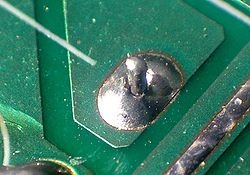Soldering

Soldering is a process in which two or more metal items are joined together. They are heated with a soldering iron. A filler metal called solder, with a relatively low melting point melts and flows into the joint, mixing with and melting a little of the items being soldered. Soft soldering is characterized by the melting point of the filler metal, which is below 400°C. Some metals such as iron are rarely soldered, because their melting point is too high.
Solder used in electronic equipment and for many other purposes has a flux to help clean the material that is soldered. The helping hand tool can make soft soldering easier by holding wires still and close together, and magnifying to see smaller wires or circuit boards.
The process can also be undone, which is called desoldering. This involves removing the solder so that the two items can be separated. This can be done by touching them with the soldering iron until the solder is liquid, then pulling them apart, but there are tools that help when trying to desolder something. Solder wick is made of very thin copper wires woven together into a long strip. When the solder wick is placed between the soldering iron and the solder, the wick absorbs the solder, and the items can be taken apart. A desoldering pump is a tube that has a small hole on one side and a plunger on the other side that can be pushed down. When the plunger is down, the small hole is placed over the solder, and then the solder is heated with the soldering iron. A button on the side of the desoldering pump can be pushed to make the plunger come back up fast enough that it creates suction that sucks the heated solder off the items and into the pump.
Soldering Media
Brazing and soldering processes classification chart
A silversmith hard soldering of silver rings using flux and silver solder wire.
Photonic soldering of multiple chips on a PET substrate using SAC305 solder. Total time = 1.68 sec.
Related pages
| Wikimedia Commons has media related to Lua error in Module:Commons_link at line 62: attempt to index field 'wikibase' (a nil value).. |







